The Manaslu region is one of the areas in Nepal that was closed for tourism until the early 90's. In 1922, the Manaslu Circuit welcomed 400 tourists, which marked the beginning of a trekking expedition in this part of Nepal.
Even after that, the region remained one of the least explored parts of the Himalayas because of its offbeat terrain and lack of trekking infrastructure. For a very long time, camping was the only way to do the Manaslu Circuit trek.
In the recent 4-5 years, ample tea houses have been opened throughout the trail, making the Manaslu Circuit much more accessible. Nevertheless, the number of trekkers in the Manaslu region is still way less than that of the famous Annapurna and Everest.
On top of the offbeat terrain, the expensive restricted area permit has also made Manaslu Circuit an off-limit for most travelers who are here on a tight budget.
As the Annapurna Circuit began to see many trekkers and road construction, its popularity decreased in the last few years. That resulted in making the Manaslu Circuit the next best circuit trek in Nepal.
As we are talking about circuit treks, we also want to introduce you to the Kanchenjunga Circuit trek. It is another excellent option if you want to go off-grid and away from crowded, famous trails.
Highlights
- Trek to the base of the eighth tallest mountain in the world, Mt. Manaslu
- Embark on an adventurous trek in one of the least explored parts of the Himalayas
- Enjoy tea house accommodation, a simple mountain lifestyle, and delicious food prepared by the locals
- Explore Tibetan refugee villages and meet with the Nupri community
- Come across ancient stupas, chortens, prayer flags, and monasteries along the trail
- Follow the Budi Gandaki River and trek deep into the valley, traversing lowlands with rice and millet terraces, lush forests, and glacier moraines
- Go on side hikes to Pun Gyen Gompa, Birendra Lake, and Rui La Pass
- Cross the challenging snow-covered Larkya La Pass
- Witness stunning landscapes and mountain vistas throughout the trek
What is the Manaslu Circuit trek like?
Manaslu is the eighth tallest mountain on Earth. The Manaslu Circuit trek takes you to its base camp and crosses the Larkya La Pass, which connects the trail to the Annapurna region.
Starting the trek from the small Barpak village, you will traverse the Tibetan-style villages, glaciers, and moraines before crossing the pass and descending to Jagat.
You can end the trek at Jagat or, as many trekkers prefer, continue the journey to Annapurna Circuit. Also, if you can spend a week more trekking, we strongly recommend you extend the Manaslu Circuit trek to the hidden Tsum Valley.
The route cuts off from Lokpa village and takes you to this beautiful, untouched section of the Manaslu region that travelers rarely visit. The mountain views are stunning, and you will get to explore ancient caves and monasteries.
The Manaslu region shares a border with Tibet. Because of the region's proximity to Tibet, many Tibetan refugees inhabit this area of Nepal. Likewise, the locals follow Tibetan Buddhism, so their beliefs, practices, and language are very similar to Tibetans.
The trekking route is dotted with stupas, chortens, prayer flags, and monasteries. You will follow the Budhi Gandaki River and trek deep into the valley. Exploring lowlands with rice and millet terraces, you will continue through lush forests and gradually ascend to beautiful Sama Gaon and Samdo villages.
Take side hikes to Pun Gyen Gompa, Manaslu Base Camp, Birendra Lake, and Rui La Pass. Navigate landslide debris and glacial tracks. Cross thrilling hanging bridges and witness stunning scenery. The route gradually goes north to the snow-covered Larkya La Pass.
Enjoy nature, wilderness, and views of Himalayan mountains such as Manaslu, Shringi Himal, Simnag Himal, Himlung Himal, Annapurna, and many others are seen on the way.
After crossing the pass, you will spend two days trekking from Bimthang to Jagat via Tilje village. The Manaslu Circuit trek ends at Jagat. You will drive from Jagat to Besisahar in a local jeep and change the vehicle to a much more comfortable tourist bus to travel back to Kathmandu.
Who can do the Manaslu Circuit trekking, and how to prepare for this once-in-a-lifetime trek?
The Manaslu Circuit trek 18 days is challenging. It suits experienced trekkers with good fitness. For beginner trekkers, the Manaslu Circuit can get very strenuous, and they may not enjoy it as much. Trekking 6 hours a day on offbeat terrain and high elevation is not easy.
You will need to put in a lot of effort, so trekkers' strength, stamina, and endurance matters. Likewise, you also have to understand that this trek is very mentally demanding.
You have to go beyond your limits and habits. Have simple meals. Spend time offline. Talk to locals and other fellow trekkers for entertainment. Relish the tranquility and sound of nature - all these things that most of us are not used to living in big cities.
If you are up for getting challenged and uncomfortable yet grounded and fulfilled, then join us on our Manaslu Circuit trek 2024/2025 departures. We will be glad to assist you during the journey. To prepare for this trek, you can exercise and go on day hikes.
Strength training and aerobic workouts are recommended. Similarly, do not forget to pack well. Get all your essentials for the trip and, most importantly, get good SPF to avoid sunburns. Buy ample snacks, energy bars, ORS, power bank, books, etc.
Altitude Sickness
Altitude sickness risk is high on the Manaslu Circuit trek because you trek 5,000 meters above sea level. Starting the trek from Barpak at 1,900 meters, you will ascend to Larkya La pass at 5,106 meters. As the elevation gain is high and most trekkers are not used to high altitude, they suffer from altitude sickness.
The one golden rule to avoid altitude sickness while high-altitude trekking is ascending gradually. Take your time to immerse yourself in the environment and enjoy your surroundings. Keep yourself hydrated and get ample rest. Make sure you are eating enough food.
- Symptoms: Headache, vomiting, nausea, dizziness, difficulty in breathing, insomnia, loss of appetite, etc.








